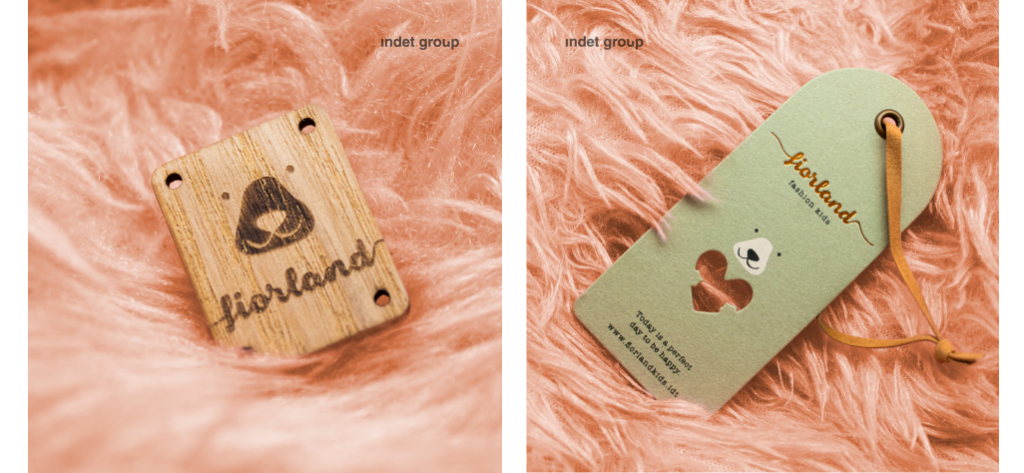We’ve discussed on several occasions the role of clothing labels in brand perception and customer purchase decisions. But what happens when it comes to children’s fashion? Unlike adult fashion, where the end consumer is the one who chooses, in the children’s sector, it is usually the parents or other adults who make the purchasing decision. However, children also have a voice and influence the purchase by expressing their tastes and preferences. Therefore, labels must connect both with adults, who seek clear information and quality design, as well as with the little ones, who may be attracted to bright colors, illustrations, and striking materials.
Moreover, children’s fashion is a dynamic market with a high turnover of products, as children grow quickly and constantly need to renew their wardrobes. This makes it even more important to stand out in order to retain customers. In this context, children’s clothing labels must not only communicate values such as quality, sustainability, comfort, and safety—factors that are valued by the adult audience—but they must also take into account the preferences of the child audience, given their influence on the purchasing decision. What factors influence this sector?
1. Colors and typhography that captivate both adults and children
In children’s fashion, colors play a crucial role. Pastel shades, bright colors, or combinations that reflect fun and cuteness can capture the attention of both parents and children. It’s important to find a balance between visual appeal and readability, ensuring that the information is clear and easy to read.
The typography should also align with the brand’s identity. For children’s labels, it’s recommended to choose rounded and friendly fonts that convey softness and approachability. If the brand has a more sophisticated focus, we can opt for more elegant fonts, but without compromising clarity.

2. Illustrations and characters: The magical touch on labels
The use of illustrations, prints, or small characters on labels can make them more memorable and attractive. Children may identify with certain visual elements, which helps create an emotional connection with the garment and the brand.
Additionally, exclusive characters can become part of the brand’s identity and encourage customer loyalty. Some labels even incorporate interactive elements, like stickers or hidden messages, to make the shopping experience more enjoyable and engaging.

3. Eco-friendly material: Commitment to the future
An increasing number of consumers are seeking sustainable options in fashion, and labels are no exception. Choosing eco-friendly materials such as recycled cardboard, organic cotton, or biodegradable labels not only reduces environmental impact but also reinforces your brand’s commitment to sustainability.
Another key aspect is durability. Labels should withstand washing and continuous use without losing quality or readability, especially for children’s clothing, which often requires more frequent washing. Some brands have even gone a step further with reusable labels that can be turned into bracelets, stickers, or small toys, adding extra value to the product.

4. Clear and well-structured information
A label should be visually appealing, but it must also be functional. It needs to provide relevant information such as size, fabric composition, care instructions, and country of manufacture. The use of icons and symbols is especially important if targeting international markets.
Additionally, including quality and sustainability certifications can be a plus for consumers, who are increasingly attentive to these details, especially when it comes to clothing for their children. Some brands even add educational messages or inspirational quotes, reinforcing their identity and creating an emotional connection.
5. Technology: A highly differentiating element
Technology plays a key role for new generations of digital natives. For this reason, some fashion brands incorporate QR codes on labels that lead to explanatory videos, interactive games, or additional brand information, enhancing the customer experience.
Another growing trend is augmented reality, which allows customers to interact with the label through mobile devices. This not only adds an innovative touch but also creates a more memorable experience, especially for a younger audience approaching adolescence.

6. A reflection of the brand in every detail
Labels should reflect the essence of the brand in every detail, even when adapting the design for different collections and seasons. From colors and typography to the tone of the message, every element should reinforce brand recognition.
For example, if the brand focuses on eco-friendly fashion, the label can convey this through sustainable materials and a minimalist design. If the brand stands out for its fun and playful character, dynamic illustrations and lighthearted messages can be included. The key is ensuring that the label design strengthens the message you want to communicate.

7. Safety and compliance with regulations
When it comes to children’s products, safety must be a top priority. Labels should comply with industry regulations to avoid potential hazards such as sharp edges, toxic inks, or materials that could pose a risk to children.
Opting for embroidered labels or printed tags on the inside of garments using hypoallergenic materials can help prevent skin irritation. Additionally, ensuring that the information remains legible after multiple washes is essential, especially for reinforcing a high-quality brand image.
Ultimately, labels on children’s clothing go beyond being just a decorative detail—they are an essential tool for communicating brand identity and creating a memorable experience for both parents and children. A well-thought-out design that reflects the company’s values and adapts to the needs and safety standards of the children’s sector can make a significant difference in customer perception. At Indet, we ensure that our labels are not only creative and functional but also soft, safe, and of high quality, always prioritizing the well-being and comfort of the little ones.




